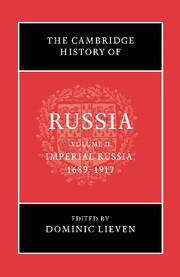Book contents
- Frontmatter
- Introduction
- Part I Empire
- Part II Culture, Ideas, Identities
- Part III Non-Russian Nationalities
- Part IV Russian Society, Law and Economy
- 11 The elites
- 12 The groups between: raznochintsy, intelligentsia, professionals
- 13 Nizhnii Novgorod in the nineteenth century: portrait of a city
- 14 Russian Orthodoxy: Church, people and politics in Imperial Russia
- 15 Women, the family and public life
- 16 Gender and the legal order in Imperial Russia
- 17 Law, the judicial system and the legal profession
- 18 Peasants and agriculture
- 19 The Russian economy and banking system
- Part V Government
- Part VI Foreign Policy and the Armed Forces
- Part VII Reform, War and Revolution
- Bibliography
- Index
- Map 5. The Russian Empire (1913). From Archie Brown, Michael Kaser, and G. S. Smith (eds.) Cambridge Encyclopedia of Russia 1982.">
- Plate Section">
- References
13 - Nizhnii Novgorod in the nineteenth century: portrait of a city
from Part IV - Russian Society, Law and Economy
Published online by Cambridge University Press: 28 March 2008
- Frontmatter
- Introduction
- Part I Empire
- Part II Culture, Ideas, Identities
- Part III Non-Russian Nationalities
- Part IV Russian Society, Law and Economy
- 11 The elites
- 12 The groups between: raznochintsy, intelligentsia, professionals
- 13 Nizhnii Novgorod in the nineteenth century: portrait of a city
- 14 Russian Orthodoxy: Church, people and politics in Imperial Russia
- 15 Women, the family and public life
- 16 Gender and the legal order in Imperial Russia
- 17 Law, the judicial system and the legal profession
- 18 Peasants and agriculture
- 19 The Russian economy and banking system
- Part V Government
- Part VI Foreign Policy and the Armed Forces
- Part VII Reform, War and Revolution
- Bibliography
- Index
- Map 5. The Russian Empire (1913). From Archie Brown, Michael Kaser, and G. S. Smith (eds.) Cambridge Encyclopedia of Russia 1982.">
- Plate Section">
- References
Summary
To the present-day observer, standing on the mansion-lined embankment overlooking the confluence of the Volga and Oka rivers, or wandering through the restored and freshly painted central streets of the city, Nizhnii Novgorod does not look so different from the provincial town it was a century ago. The massive automobile factory, the military installations and large-scale industry of the Soviet city of Gorky – all of which closed the area to foreigners until 1991 – sprouted around the edges while leaving the city centre intact. Only the cupolas which once studded the streets like points of gold have vanished, victims of the 1929 eradication of churches. Nizhnii Novgorod boasts all the features of the most lovely of Russian provincial towns: perched picturesquely atop a network of ravines, it nevertheless follows a strictly Petersburgian layout with the three straight avenues radiating from the central kremlin. The above mentioned observer can walk to the edge of the promenade to look out over the Oka at the old fairgrounds and the massive nineteenth-century Alexander Nevsky cathedral on the promontory. Across the Volga, in the meantime, forests still stretch north as far as one can see, past the pilgrimage site of Lake Svetloiar, whose depths conceal the lost city of Kitezh, and the historical refuge of the Old Belief.
Topography
The comfortable provincial ease with which Nizhnii Novgorod straddles bluffs and ravines was in fact the product of a concerted effort involving the central government, local authorities and the town population itself. The history of urban planning for Nizhnii Novgorod as for many Russian cities begins with Catherine the Great’s 1785 Charter to the Towns, which not only bestowed certain privileges upon town dwellers, but converted frontier outposts and administrative centres into ‘proper’ imperial cities with regular street plans and municipal institutions.
- Type
- Chapter
- Information
- The Cambridge History of Russia , pp. 264 - 283Publisher: Cambridge University PressPrint publication year: 2006

